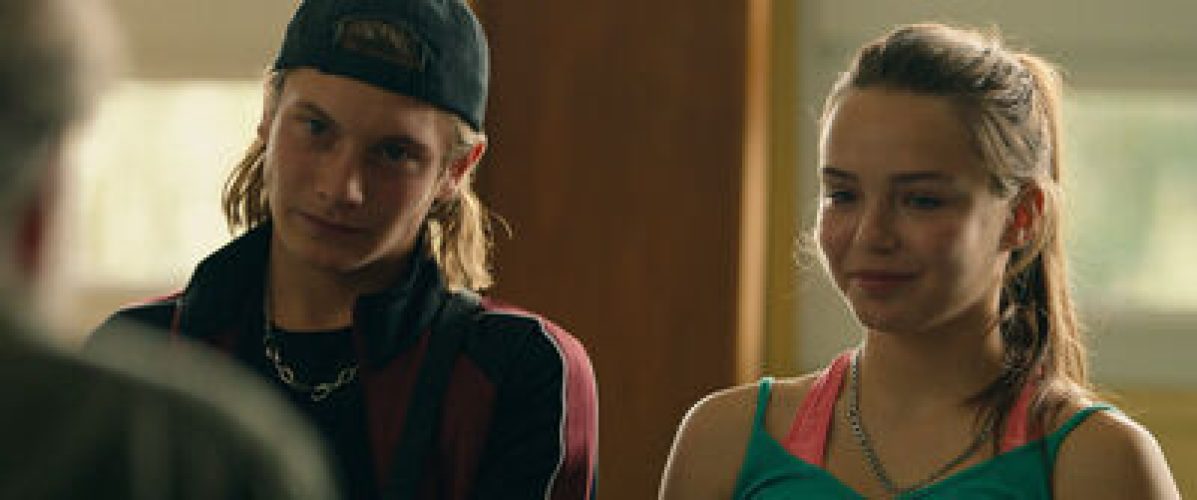“The Worst Ones” revolves around the production of a film-within-a-film, whose director, Gabriel (Johan Heldenbergh), insists on casting nonprofessional actors for vague reasons concerning authenticity. The four kids he chose were all plucked from the cité Picasso housing project in a poor suburb of the small French town of Boulogne-Sur-Mer. Locals wonder aloud why the crew picked “the worst ones” that their neighborhood has to offer to represent it on screen.
The film takes the circumstances of each child’s real life and exaggerates them in stereotypical ways: A teenage outcast is cast as a pregnant 15-year-old, for example, while a boy recently released from juvenile detention plays her incarcerated lover. Gabriel and his crew have stirred up controversy in the community, which objects to the portrayal of cité Picasso as—they don’t use the term “poverty porn,” but that’s essentially the charge. The film people defend their work, saying that they’re actually out to defy the stereotypes and it’s all worth it because it’s for art. But what if that art … sucks?
That’s the kind of trick this subtle film plays on its viewers, pushing clouds aside one by one until a truth bursts through like a ray of sunlight. There’s another movie to be made here, skewering the clueless liberal sensibilities of Gabriel and his crew. But this isn’t that film, even if the climactic moment in Gabriel’s magnum opus is pretentious and a little silly. Instead, directors Lise Akoka and Romane Gueret’s primary intention with “The Worst Ones” is to show how being cast in this film affects the child actors.
Akoka and Gueret are generous with all of their characters, including Gabriel. Production assistant Judith (Esther Archambault) takes a genuine interest in Lily (Mallory Wanecque), the unpopular teenage girl mentioned above. Lily—who hasn’t been the same since her little brother died of cancer—has been branded a “slut” by her peers. And her role in the film isn’t helping. The boy who plays her little brother in the movie, Ryan (Timéo Mahault), has the same emotional issues as his character. And as we see in a scene where the boy’s estranged mother has to justify it to a social worker, his participation in the project further destabilizes his already shaky home life.
Much of the film concentrates on following Lily and Ryan chronologically through the production. from casting to the wrap party. Volatile Jessy (Loïc Pech) and withdrawn Maylis (Melina Vanderplancke) play supporting roles in this movie and Gabriel’s. Maylis turns out to be the one character who sees clearly everything that’s going on around her and quits the production midway through. “I just didn’t like it,” she mutters when Gabriel presses her for a reason why.
“The Worst Ones” also uses nonprofessional actors for its core ensemble: Out of the main cast, Heldenbergh is the only one who’s ever appeared in a feature film before this one. That puts the movie in a tricky situation as it attempts to sidestep the same exploitation it’s critiquing in the film-within-a-film and, by extension, the industry as a whole. Here, the realistic setting and focus on the child actors are an asset. When the camera lingers on Manecque’s face as she watches older, more glamorous crew members partying after a long day on set or on Mahault’s as he inspects the bird cages that are a big part of his character’s story arc, it captures something pure and unaffected that says more about the boxes that society puts these kids into than any monologue or plot contrivance.
That’s not to say that “The Worst Ones” considers itself above exploitative film industry practices. (Well, maybe a little.) This is one of those movies that shows rather than tells—always preferable, even in the moments when the big picture is still coming into focus. Even the film’s ickiest stretch, where Gabriel clumsily fumbles through the filming of a sex scene featuring two underage amateurs playing even younger characters, creeps up slowly rather than smacking you in the face with how distressing it all is.
“The Worst Ones” can sometimes feel slight for this exact reason. There are moments where the satire could cut a little deeper, or the drama could be a little more dramatic. But that’s just the movies. In real life, we all have to figure out for ourselves how much good intentions mitigate negative impacts or whether artistic expression justifies exploitation on any level. By refusing to answer these questions, “The Worst Ones” stays true to itself.
Now playing in theaters.
“The Worst Ones” revolves around the production of a film-within-a-film, whose director, Gabriel (Johan Heldenbergh), insists on casting nonprofessional actors for vague reasons concerning authenticity. The four kids he chose were all plucked from the cité Picasso housing project in a poor suburb of the small French town of Boulogne-Sur-Mer. Locals wonder aloud why the crew picked “the worst ones” that their neighborhood has to offer to represent it on screen. The film takes the circumstances of each child’s real life and exaggerates them in stereotypical ways: A teenage outcast is cast as a pregnant 15-year-old, for example, while a boy recently released from juvenile detention plays her incarcerated lover. Gabriel and his crew have stirred up controversy in the community, which objects to the portrayal of cité Picasso as—they don’t use the term “poverty porn,” but that’s essentially the charge. The film people defend their work, saying that they’re actually out to defy the stereotypes and it’s all worth it because it’s for art. But what if that art … sucks? That’s the kind of trick this subtle film plays on its viewers, pushing clouds aside one by one until a truth bursts through like a ray of sunlight. There’s another movie to be made here, skewering the clueless liberal sensibilities of Gabriel and his crew. But this isn’t that film, even if the climactic moment in Gabriel’s magnum opus is pretentious and a little silly. Instead, directors Lise Akoka and Romane Gueret’s primary intention with “The Worst Ones” is to show how being cast in this film affects the child actors. Akoka and Gueret are generous with all of their characters, including Gabriel. Production assistant Judith (Esther Archambault) takes a genuine interest in Lily (Mallory Wanecque), the unpopular teenage girl mentioned above. Lily—who hasn’t been the same since her little brother died of cancer—has been branded a “slut” by her peers. And her role in the film isn’t helping. The boy who plays her little brother in the movie, Ryan (Timéo Mahault), has the same emotional issues as his character. And as we see in a scene where the boy’s estranged mother has to justify it to a social worker, his participation in the project further destabilizes his already shaky home life. Much of the film concentrates on following Lily and Ryan chronologically through the production. from casting to the wrap party. Volatile Jessy (Loïc Pech) and withdrawn Maylis (Melina Vanderplancke) play supporting roles in this movie and Gabriel’s. Maylis turns out to be the one character who sees clearly everything that’s going on around her and quits the production midway through. “I just didn’t like it,” she mutters when Gabriel presses her for a reason why. “The Worst Ones” also uses nonprofessional actors for its core ensemble: Out of the main cast, Heldenbergh is the only one who’s ever appeared in a feature film before this one. That puts the movie in a tricky situation as it attempts to sidestep the same exploitation it’s critiquing in the film-within-a-film and, by extension, the industry as a whole. Here, the realistic setting and focus on the child actors are an asset. When the camera lingers on Manecque’s face as she watches older, more glamorous crew members partying after a long day on set or on Mahault’s as he inspects the bird cages that are a big part of his character’s story arc, it captures something pure and unaffected that says more about the boxes that society puts these kids into than any monologue or plot contrivance. That’s not to say that “The Worst Ones” considers itself above exploitative film industry practices. (Well, maybe a little.) This is one of those movies that shows rather than tells—always preferable, even in the moments when the big picture is still coming into focus. Even the film’s ickiest stretch, where Gabriel clumsily fumbles through the filming of a sex scene featuring two underage amateurs playing even younger characters, creeps up slowly rather than smacking you in the face with how distressing it all is. “The Worst Ones” can sometimes feel slight for this exact reason. There are moments where the satire could cut a little deeper, or the drama could be a little more dramatic. But that’s just the movies. In real life, we all have to figure out for ourselves how much good intentions mitigate negative impacts or whether artistic expression justifies exploitation on any level. By refusing to answer these questions, “The Worst Ones” stays true to itself. Now playing in theaters. Read More


